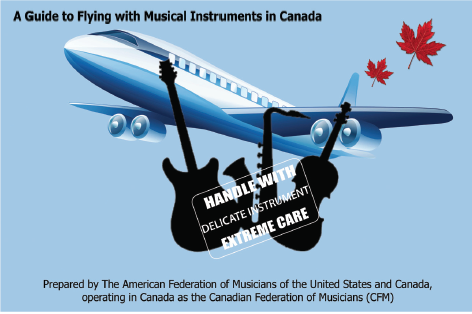After four years of lobbying the government of Canada, as well as meeting with airline councils, the Canadian Transport Agency, Minister of Transport, The Honorable Marc Garneau, and his staff at Transport Canada, I am pleased to share the news that, as part of the new Passenger Bill of Rights within the Canadian Transportation Act, we now have language in Canada with regard to musicians travelling with instruments on airlines in Canada.
Effective July 15, Air Passenger Protection Regulations within the Canadian Transportation Act included language to ensure that all air carriers must accept musical instruments unless security or safety is an issue.
The airline industry battled hard to avoid the new bill, however, Minister Garneau and his staff at Transport Canada held strong in favor of passenger rights. As such a small part of a major bill, we were thrilled to affect language and changes to the industry and find support from Minister Garneau in our efforts to better represent musicians travelling in Canada.
We have prepared a Canadian Flying Guide in both English and French, which can be found online at:
• www.afm.org/what-we-are-doing/travel-resources/afm-travel-kit/ under “Carry On Your Instrument” and “Carry On Your Larger Instrument” tabs
• www.cfmusicians.org/uploads/file/CAD%20Flying%20Guide%20-%20Final%20English.pdf
• www.cfmusicians.org/uploads/file/CAD%20Flying%20Guide%20-%20French%20Version.pdf
Each airline also will have clear guidelines published as part of their tariff. Under the law, all commercial airline carriers must accept musical instruments as checked or carry-on baggage, unless it is contrary to general terms and conditions in the carrier’s tariff with respect to the weight or dimension of baggage or because of safety or security.
Many thanks to President Hair and VPC Alan Willaert for their support and investment into lobbying the Canadian government on behalf of all musicians.

Nouveau guide sur les déplacements en avion, en anglais et en français
Allistair Elliott, représentant international pour le Canada
Après quatre ans de lobbying auprès du gouvernement du Canada et de rencontres avec le Conseil national des lignes aériennes du Canada, l’honorable Marc Garneau ainsi que son équipe à Transport Canada, j’ai le plaisir de vous annoncer que le Canada est désormais doté d’une réglementation régissant le transport d’instruments de musique par avion dans le cadre de la Déclaration des droits des passagers aériens de la Loi sur les transports au Canada.
En vigueur depuis le 15 juillet, le Règlement sur la protection des passagers aériens, qui fait partie de la Loi sur les transports au Canada, contient des dispositions obligeant tous les transporteurs à accepter les instruments de musique à bord de leurs avions, à moins que ceux-ci ne présentent un risque pour la sécurité.
Les compagnies aériennes se sont battues becs et ongles pour empêcher l’adoption du projet de loi, mais le ministre Garneau et le personnel de Transport Canada n’ont pas cédé. Comme nos revendications ne touchaient qu’une petite partie d’un projet de loi majeur, nous avons été ravis de constater que nous avions du poids ey que nous pouvions compter sur l’appui du ministre Garneau pour mieux défendre les intérêts des musiciens qui voyagent par avion au Canada.
Nous avons conçu un guide sur les déplacements en avion, en anglais et en français, que vous trouverez en ligne au :
www.afm.org/what-we-are-doing/travel-resources/afm-travel-kit/ Sous les onglets
« Le transport de votre instrument à bord de l’avion » et « Le transport de votre instrument de grande taille à bord des avions » de la page Trousse de voyage de l’AFM
www.cfmusicians.org/uploads/file/CAD%20Flying%20Guide%20-%20Final%20English.pdf
www.cfmusicians.org/uploads/file/CAD%20Flying%20Guide%20-%20French%20Version.pdf
Chaque compagnie aérienne publiera par ailleurs des directives claires dans le cadre de son tarif. En vertu de la loi, tous les transporteurs aériens commerciaux sont tenus d’accepter les instruments de musique comme bagage enregistré ou à main, à moins d’indication contraire dans les modalités générales du tarif du transporteur en ce qui a trait au poids, à la dimension ou aux risques pour la sécurité.
Je remercie chaleureusement Ray Hair, président, et Alan Willaert, vice-président, pour leur soutien et le temps qu’ils ont investi dans les activités de lobbying au nom des musiciens canadiens.










